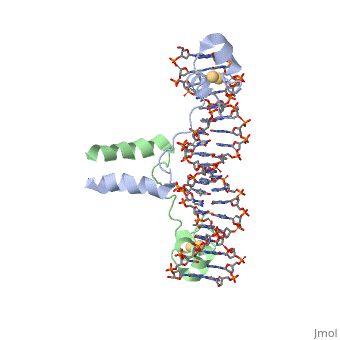Sandbox Reserved 1750
From Proteopedia
(Difference between revisions)
| Line 7: | Line 7: | ||
</table> | </table> | ||
== Function == | == Function == | ||
| - | [[https://www.uniprot.org/uniprot/GAL4_YEAST GAL4_YEAST]] This protein is a positive regulator for the gene expression of the galactose-induced genes such as GAL1, GAL2, GAL7, GAL10, and MEL1 which code for the enzymes used to convert galactose to glucose. It recognizes a 17 base pair sequence in (5'-CGGRNNRCYNYNCNCCG-3') the upstream activating sequence (UAS-G) of these genes. This sequence is correctly shown on the structure as (5'-CGGAGGACTGCCCTCCG-3'). <scene name='92/925538/Dna_protein_interaction/ | + | [[https://www.uniprot.org/uniprot/GAL4_YEAST GAL4_YEAST]] This protein is a positive regulator for the gene expression of the galactose-induced genes such as GAL1, GAL2, GAL7, GAL10, and MEL1 which code for the enzymes used to convert galactose to glucose. It recognizes a 17 base pair sequence in (5'-CGGRNNRCYNYNCNCCG-3') the upstream activating sequence (UAS-G) of these genes. This sequence is correctly shown on the structure as (5'-CGGAGGACTGCCCTCCG-3'). <scene name='92/925538/Dna_protein_interaction/3'>The DNA-Protein Interaction</scene> with all of the base pairs within 5 angstroms of the protein highlighted illustrates that the protein interacts with both strands of the UAS. |
== Evolutionary Conservation == | == Evolutionary Conservation == | ||
[[Image:Consurf_key_small.gif|200px|right]] | [[Image:Consurf_key_small.gif|200px|right]] | ||
| Line 20: | Line 20: | ||
<div style="background-color:#fffaf0;"> | <div style="background-color:#fffaf0;"> | ||
== Publication Abstract from PubMed == | == Publication Abstract from PubMed == | ||
| - | A specific DNA complex of the 65-residue, N-terminal fragment of the yeast transcriptional activator, GAL4, has been analysed at 2.7 A resolution by X-ray crystallography. The protein binds as a <scene name='92/925538/Dimer/2'>dimer</scene> to a symmetrical 17-base-pair sequence. There is a compact <scene name='92/925538/Metal_binding_domain/5'>metal binding domain</scene> (residues 8-40), an <scene name='92/925538/Extended_linker/ | + | A specific DNA complex of the 65-residue, N-terminal fragment of the yeast transcriptional activator, GAL4, has been analysed at 2.7 A resolution by X-ray crystallography. The protein binds as a <scene name='92/925538/Dimer/2'>dimer</scene> to a symmetrical 17-base-pair sequence. There is a compact <scene name='92/925538/Metal_binding_domain/5'>metal binding domain</scene> (residues 8-40), an <scene name='92/925538/Extended_linker/4'>extended linker</scene> (41-49), and an <scene name='92/925538/Alpha-helical_dimerization/2'>alpha-helical dimerization element</scene> (50-64). A small, Zn(2+)-containing domain recognizes a conserved CCG triplet at each end of the site through direct contacts with the major groove. The metal binding domain contains <scene name='92/925538/Cysteine_metal_binding/3'>cysteine residues</scene> that coordinate to the metal as shown as cadmium. A short coiled-coil dimerization element imposes 2-fold symmetry. A segment of extended polypeptide chain links the metal-binding module to the dimerization element and specifies the length of the site. The relatively open structure of the complex would allow another protein to bind coordinately with GAL4. |
DNA recognition by GAL4: structure of a protein-DNA complex.,Marmorstein R, Carey M, Ptashne M, Harrison SC Nature. 1992 Apr 2;356(6368):408-14. PMID:1557122<ref>PMID:1557122</ref> | DNA recognition by GAL4: structure of a protein-DNA complex.,Marmorstein R, Carey M, Ptashne M, Harrison SC Nature. 1992 Apr 2;356(6368):408-14. PMID:1557122<ref>PMID:1557122</ref> | ||
Revision as of 21:56, 19 September 2022
DNA RECOGNITION BY GAL4: STRUCTURE OF A PROTEIN/DNA COMPLEX
| |||||||||||


